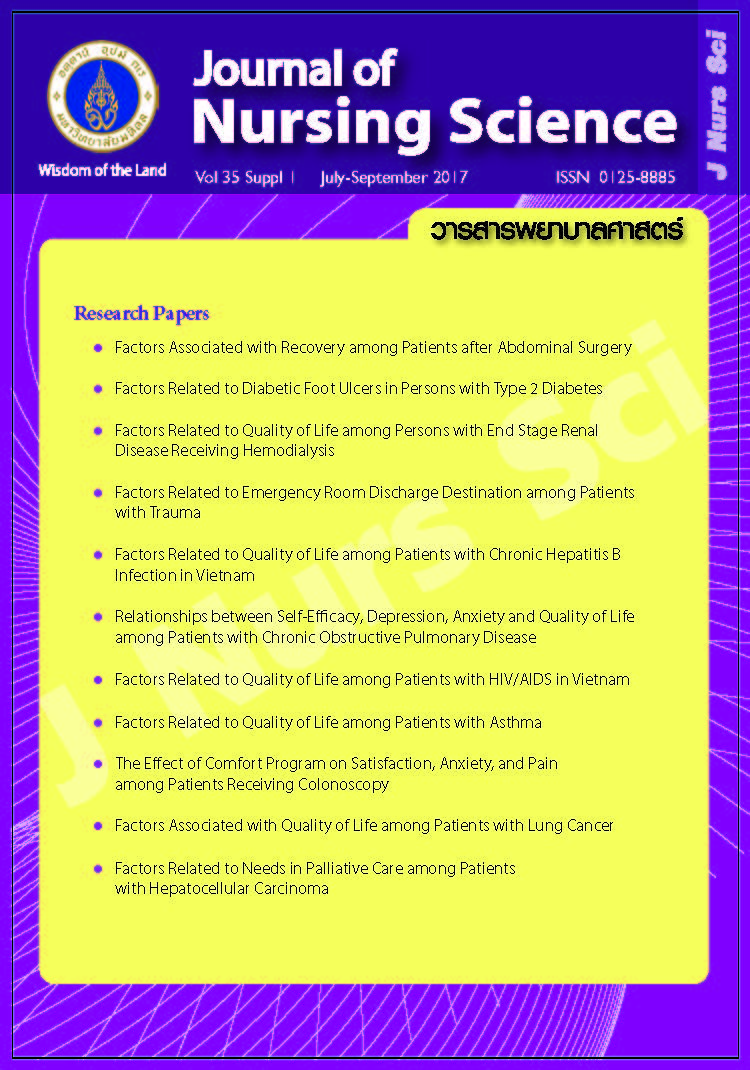Factors related to Emergency Room Discharge Destination among Patients with Trauma ปัจจัยที่มีความสัมพันธ์กับปลายทางการจำหน่ายจากห้องฉุกเฉินของผู้ป่วยบาดเจ็บ
Main Article Content
บทคัดย่อ
Purpose: To investigate the relationships between age, physiological deterioration, co-morbidity and emergency room discharge destination among patients with trauma.
Design: Descriptive correlation design.
Methods: The sample composed of 300 patients with traumatic injuries in emergency department, Bach Mai Hospital in Hanoi, Vietnam. Data were collected from the patient’s hospital chart. Spearman’s Rho was employed to test the relationships among studies variables.
Main findings: Approximately 60% of patients with traumatic injuries (59.7%) were admitted in hospital, while 35.4% received surgery and/or admitted to intensive care unit. About 40.3% received treatment and were discharged from emergency department to home. Physiological deterioration as measured by Modified Early Warning Score, age, and co-morbidity were positively correlated with emergency room discharge destination (rs = .38, rs = .14, rs = .16, p < .05).
Conclusion and recommendations: Modified Early Warning Score should be used to classify trauma injuries patients on their arrival at the emergency department. Hence, the patients can receive appropriate treatment at the right time. Co-morbid diseases should be routinely assessed in all trauma injuries patients on arrival at the emergency room.
บทคัดย่อ
วัตถุประสงค์: เพื่อศึกษาความสัมพันธ์ระหว่าง อายุ การเปลี่ยนแปลงทางสรีระ และโรคร่วมกับปลายทางการจำหน่ายจากห้องฉุกเฉินของผู้ป่วยบาดเจ็บ
รูปแบบการวิจัย: การวิจัยเชิงสหสัมพันธ์
วิธีดำเนินการวิจัย: กลุ่มตัวอย่างประกอบด้วยผู้ป่วยบาดเจ็บจำนวน 300 คน ที่เข้ารับการรักษา ณ ห้องฉุกเฉิน ของโรงพยาบาล บัคมาย กรุง ฮานอย ประเทศเวียดนาม โดยเก็บข้อมูลจากเวชระเบียนของผู้ป่วย วิเคราะห์ความสัมพันธ์ระหว่างตัวแปรด้วยการใช้สถิติ Spearman’s Rho
ผลการวิจัย: กลุ่มตัวอย่างร้อยละ 59.7 ได้รับการรักษาตัวในโรงพยาบาล ในจำนวนนี้ร้อยละ 35.4 ได้รับการรักษาด้วยการผ่าตัดและรับการรักษาตัวในหอผู้ป่วยหนัก ผู้ป่วยร้อยละ 40.3 ได้รับการรักษาแบบผู้ป่วยนอกและได้รับการจำหน่ายกลับบ้าน การเปลี่ยนแปลงทางสรีระซึ่งประเมินโดย Modified Early Warning Score (MEWS) อายุของผู้ป่วย และการมีโรคร่วม มีความสัมพันธ์ทางบวกกับปลายทางการจำหน่ายจากห้องฉุกเฉิน (rs= .38, rs = .14, rs = .16, p < .05)
สรุปและข้อเสนอแนะ: ผู้ป่วยบาดเจ็บฉุกเฉินทุกคนควรได้รับการประเมินภาวะการเปลี่ยนแปลงทางสรีระด้วย Modified Early Warning Score และได้รับการประเมินโรคร่วม เมื่อมาถึงห้องฉุกเฉิน เพื่อใช้ในการตัดสินใจในการรักษาที่ถูกต้องภายในเวลาที่เหมาะสม
Article Details
ลิขสิทธิ์: วารสารพยาบาลศาสตร์เป็นเจ้าของลิขสิทธิ์ในการเผยแพร่ผลงานที่ตีพิมพ์ ห้ามผู้ใดนำบทความที่ได้รับการตีพิมพ์ในวารสารพยาบาลศาสตร์ไปเผยแพร่ในลักษณะต่างๆ ดังต่อไปนี้ การส่งบทความไปตีพิมพ์เผยแพร่ที่อื่น การนำบทความเผยแพร่ออนไลน์ การถ่ายเอกสารบทความเพื่อกิจกรรมที่ไม่ใช่การเรียนการสอน ยกเว้นเสียแต่ได้รับอนุญาตจากวารสารพยาบาลศาสตร์

Disclaimer: เนื้อหาบทความหรือข้อคิดเห็นใดๆ ในวารสารพยาบาลศาสตร์ ถือเป็นความรับผิดชอบของผู้เขียน กองบรรณาธิการไม่จำเป็นต้องเห็นด้วยและไม่มีส่วนรับผิดชอบแต่อย่างใด
เอกสารอ้างอิง
2. Negoi I, Paun S, Hostiuc S, Stoica B, Tanase I, Negoi R I, et al. Mortality after acute trauma: progressive decreasing rather than a trimodal distribution. Journal of Acute Disease. 2015;4(3):205-9.
3. Haider AH, Chang DC, Haut ER, Cornwell EE 3rd, Efron DT. Mechanism of injury predicts patient mortality and impairment after blunt trauma. J Surg Res. 2009;153(1):138-42.
4. Cameron PA, Gabbe BJ, Smith K, Mitra B. Triaging the right patient to the right place in the shortest time. Br J Anaesth. 2014;113(2):226-33.
5. Elias P, Damle A, Casale M, Branson K, Churi C, Komatireddy R, et al. A web-based tool for patient triage in emergency department settings: validation using the emergency severity index. JMIR Med Inform. 2015;3(2):e23. doi: 10.2196/medinform.3508.
6. Gilboy N, Tanabe P, Travers D, Rosenau AM. Emergency Severity Index (ESI): a triage tool for emergency department care, version 4: implementation handbook, 2012 edition. Rockville, MD: Agency for Healthcare Research and Quality; 2011.
7. Chen AY, Zagorski B, Parsons D, Vander Laan R, Chan V, Colantonio A. Factors associated with discharge destination from acute care after acquired brain injury in Ontario, Canada. BMC Neurol. 2012;12:16. doi: 10.1186/1471-2377-12-16.
8. Iankova A. The Glasgow coma scale clinical application in emergency departments. Emerg Nurse. 2006;14(8):30-5.
9. Burch VC, Tarr G, Morroni C. Modified early warning score predicts the need for hospital admission and in hospital mortality. Emerg Med J. 2008;25(10):674-8.
10. Subbe CP, Kruger M, Rutherford P, Gemmel L. Validation of a Modified Early Warning Score in medical admissions. QJM. 2001;94(10):521-6.
11. So SN, Ong CW, Wong LY, Chung JY, Graham CA. Is the Modified Early Warning Score able to enhance clinical observation to detect deteriorating patients earlier in an accident & emergency department? Australas Emerg Nurs J. 2015;18(1):24-32.
12. Gottschalk SB, Warner C, Burch VC, Wallis LA. Warning scores in triage – Is there any point? Afr J Emerg Med. 2012;2(3):103-7.
13. Wardle TD. Co-morbid factors in trauma patients. Br Med Bull. 1999;55(4);744-56
14. Kodadek LM, Selvarajah S, Velopulos CG, Haut ER, Haider AH. Undertriage of older trauma patients: is this a national phenomenon? J Surg Res. 2015;199(1):220-9.
15. Lehmann R, Beekley A, Casey L, Salim A, Martin M. The impact of advanced age on trauma triage decisions and outcomes: a statewide analysis. Am J Surg. 2009;197(5):571-5.
16. Merani S, Payne J, Padwal RS, Hudson D, Widder SL, Khadaroo RG. Predictors of in-hospital mortality and complications in very elderly patients undergoing emergency surgery. World J Emerg Med. 2014;9:43. doi: 10.1186/1749-7922-9-43.
17. Fridley J, Robertson C, Gopinath S. Quantitative lobar cerebral blood flow for outcome prediction after traumatic brain injury. J Neurotrauma. 2015;32(2):75-82.


